Welcome to the ultimate kitesurfing guide for Thailand. It’s the biggest and most up-to-date guide you can find on the internet answering all questions you might have before starting your new passion. If you feel something is missing, send us an email or contact by WhatsApp with your questions and we gonna add them as soon as possible!
In this guide you’ll learn everything about kitesurfing in Thailand starting from its benefits, kite theory, stages of learning, kite spots in Thailand as well as you are going to find some tips in choosing a proper environment to start this awesome sport.
a. Easy to learn
b. Sport for everybody
c. It’s safe
d. Freedom
e. Make other boardsports easier
f. Diversity of Disciplines
g. Mental and Physical Benefits
h. Kitesurfing scene and vibe
i. Traveling
a. Beautiful kitesurfing spots
b. Weather and wind in Thailand
c. Many kitesurfing schools
d. Easy to get around the country
e. Big variety of accomodation
f. Affordable cost of living
g. Food
h. Safety
i. Unique Thai culture
j. Hundreds of activities outside kitesurfing
k. High quality service
The first and the most important reason why you should give kitesurfing, especially in Thailand, a try is that it’s currently one of the easiest water sport available on the market. Compared to other popular sports like surfing, windsurfing or water skiing, kitesurfing requires much less strength and effort. Average number of hours needed to learn kitesurfing is significantly smaller than learning any of the sports mentioned above.
Imagine yourself cruising on your own in the ocean, flying high, riding waves or making spectacular tricks. It’s way easier than you think it’s! And progressing through the next milestones gives you the endless satisfaction.
Kitesurfing doesn’t require you to be strong or super fit. It’s the sport based on technique, not on strength of your arms. In fact, the kite pulls you by the harness attached to your waist and you use hands just to steer the kite. With this being said it’s the sport for everybody regardless of age or gender. Seeing people 60+ trying their luck starts to be a common picture in every kite spot.
However, if you do have any health problem, it’s better to contact your potential kite school first to avoid unnecessary problems in the future or just simply to check if they do have a correct equipment for you (for example: seat harness for people with back pain problems)
Seeing somebody falling from a few meters or crashing the water in a dramatic way seems to be dangerous but again it just looks way worse than it is in reality.
First of all – crashing into the water is way more forgiving than falling on the the ground (playing football for example) or crashing on a ski slope while skiing or snowboarding. It’s simply not painful.
Secondly, by choosing a certified and professional kitesurfing school or/and instructor, you reduce the chances of getting injured almost to zero. This point is absolutely crucial, as you have to have all the kitesurfing rules, equipment, safety systems explained clearly as well as you need to learn how to get out of every situation comfortably on your own.
Lastly, as mentioned above, kitesurfing equipment is full of safety systems: you can easily drop the power to zero in no time or activate any of the safety systems that will let you stay unharmed.
It’s hard to find any sport on the market that gives you potentially more freedom than kitesurfing is giving. It’s not only letting you cruise by yourself wherever you want but it also lets you make moves in the air (if you want) by jumping and flying. Both cruising and flying gives you unbelievable feelings, mix of adrenaline and euphoria. The healthiest way to release all the endorphins!
Moreover, once you will be able to ride on your own, you can choose one of the few disciplines this sport has to offer, each of them giving you a completely unique experience. Most of them require different types of board.
You can learn kitesurfing in Thailand and then go to Swiss Alps to learn snowboarding with way better results. Kitesurfing, snowboarding, wakeboarding and skateboarding are very similar sports and learning one of them opens doors to all the rest. They share the majority of moves on the beginner’s level therefore if you learnt any of these sports, it will help you learn all others even faster!
Once you get to the point where you can easily ride by yourself, you can decide what part of the kitesurfing you are the most excited about practicing and evolve by following the paths of one of the discipines. And there is plenty of choice, each of them offering you a completely unique experience and most of them using different types of boards.
As the name says it’s a discipline about jumping and flying - as high as possible. It’s currently the most popular and thrilling discipline that skyrockets your adrenaline. The current jump height record is over 36 meters! Don’t worry though - to achieve this, you would need to kitesurf daily in the most extreme conditions with special kites being one of the best in the world. Learning this discipline starts from tiny jumps that will already give you unforgettable memories. Also, before you start practicing on your own, it's a good idea to sign up for some jumping lessons - it’ll simply make it safer and way more effective. Fly High Kiteboarding is definitely the way to go.
If you ever seen or heard of wakeboarding, this is a discipline very similar to it known for its technical rotations. In fact both freestyle and wakeboarding share the majority of moves and tricks so you can practice them by kiting and then doing exactly the same in any wakepark.In this discipline you would need to swap your regular board with straps to the board with boots to avoid sliding off of your board during rotation landings. Name unhooked comes from unhooking yourself from the harness so you get all the kite pull power transferred to your arms. This discipline is a little bit more physically demanding.During freestyle you use different types of kites that won’t really let you fly. Instead you jump by popping - which basically means carving with your board against the direction of pull that shoots you a few meters up and the goal is to finish rotation before you land.
The most common discipline for regular riders. Freeride means basically doing whatever you want. Kites used in this discipline let you taste both: big air as well as freestyle.In addition, freeride has some unique variety of tricks. Let’s call them swing-tricks. These tricks base on sliding on the water and using the kite as a swig. Most popular tricks: Jesus Walk, Darkslide, Handrag. This discipline uses a standard kitesurfing board - twin tip. Board looks like the one used in snowboarding but with the straps instead of boots.
It’s actually been two different disciplines on their own. One is about riding the waves, another one about doing tricks. One thing that connects them both is a surfboard with no straps..Have you ever tried surfing and got bored or exhausted from paddling? If the answer is yes then this category of kitesurfing is a perfect match for you. Save a lot of energy and seek only for what’s most exciting in surfing - catching a wave. Let the kite pull you into the wave instead of waiting and paddling to it.
Have you ever dreamt of levitating above the surface of water? Foiling is the newest and the most relaxing discipline in kitesurfing. Especially good for days with lighter winds, giving you a unique experience of cruising above the water. The main reason it happens is the special board with a mast and the wing connected underneath it. . The wing underneath the board looks similarly to an airplane. Once you get some speed, an airplane that is underwater pulls your board above the water level. This type of boards are also used for all racing competitions in kitesurfing.
Kitesurfing is a sport that you will benefit from in many ways. It’s a complex training that engages most of your muscles and thanks to adrenaline you won’t feel neither bored nor tired until you get back to the beach. It’s a perfect sport for people who are not big fans of repetitive exercises but want to keep their fitness up.
From a mental point of view, it helps in releasing the stress, let you rest mentally and even have a positive impact in healing depression as this sport releases a lot of endorphins. It’s very euphoric! Having just ocean around and being powered by the elements can work well as meditation too.
The community of kitesurfers is full of beautiful souls around all the world that will always help you if needed. In fact, to launch a kite we need the assistance of others. In many spots famous for its kitesurfing you will find a lot of events or parties related to it. The atmosphere is full of smiles and laughs. It’s not a coincidence. We’re all living on the beach most of the year
As mentioned in the previous point, kitesurfing is a seasonal sport. Not many places in the world guarantee you wind 24/7, 365 days of the year. And that’s awesome! As it’s another reason to visit new countries, new cultures, new people, new spots and new food! Some of the best kitesurfing places in the world:
Asia – Thailand, Vietnam
Europe – Netherlands, Italy, Greece
Africa – Mauritius, Marocco, South Africa
America – Mexico, Brasil, USA
Oceania – Perth, Melbourne (Australia)
You can easily pack your equipment, in some cases even as a carry-on luggage as some of the boards are splittable and the kite that is packed is the size of a sleeping bag.
With such a long coastline and dozens of islands, we could easily bet blindfolded that Thailand is a great place to do kitesurfing and naturally it offers diversity. From long and pristine beaches to hidden lagoons surrounded by jungle. From wavy spots to flat shallow water. From busy places with a lot of kitesurfers to calm paradises where you can be the only one in the water. And that’s exactly why kitesurfing in Thailand is so fun.
Forget about wetsuits. The temperature of water in Thailand is around 25-30 degrees (in celcius) all year. There might be days that are colder but in general you will kite in boardshorts / bikini all the time. Same goes for air temperature that rarely drops below 25 degrees even at night in southern and central Thailand where all spots are located.
As for wind – kitesurfing locations in Thailand don’t always share the same windy seasons. It means that some locations start it earlier or finish later. You can easily check wind yourself on websites / apps such as windguru, windy or windfinder. You always can also text your kite school about the conditions for the following days.
Competition makes us all bettter! In Thailand, you can choose from many kite schools that offer different packages, different prices, different kite equipment or teach in different languages. Most of the schools in the world teach according to the same program – it’s either IKO or VDWS. Finishing a course under this program will get you a certification that you can use to rent equipment on your own or just to continue lessons in any other country from the moment you recently finished.
We DO NOT recommend choosing schools that are not teaching under these programs. These organizations put a lot of emphasis on safety and effective teaching. ALWAYS check the certification of your instructor or choose Fly High Kiteboarding where all instructors are certified.
Traveling in Thailand is extremely comfortable (even with your own quiver of kites) with very well organized public transport and many options available from metros and skytrains in Bangkok, car and motorbike rentals, regular trains, buses, ferries to domestic flights. On top of that, traveling in Thailand is cheap! You can easily find domestic flights starting from $25 and hop from one spot to another or just go exploring. During high season, these prices might go up a little due to high demand but it’s still very affordable. The most popular domestic flight companies are Air Asia, Nok-Air or VietJet. The rest of the trip you can plan with 12go.asia or with Moovit app.
Bungalow on the beach? Checked.
5* hotel? Checked
Flat with a swimming pool on the top of the building? Checked
Hostel? Checked.
Resort? Yes, sir.
Apartments? Hundreds of choice
And that’s starting from $10-15 a night. In some places it can go even cheaper! Thailand offers a huge variety of accommodation for everyone. Most of the places have AC as well as WiFi. You can easily find an accommodation next to your kitespot or choose something different that matches your expectations and come to the spot by motorbike.
Everything: service, food, transport, accommodation and gas is incomparably cheaper than any western country. You can make kitesurfing holidays with a higher standard by ½ of the price you would pay in the majority of European countries.
Same goes for kitesurfing lessons. For example: 2hr kitesurfing lesson in Amsterdam will cost you $180, 2hr lesson of kitesurfing in Koh Phangan with Fly High Kiteboarding will cost you $100.
We can argue about the title for the best cuisine in the world. Some people might say it’s Italian, some people may say it’s French. No doubt that the majority of people in the world rank Thai cuisine in their top 3 and everyone can find something for oneself in it.
You can find a lot of food on every street and it’s so affordable that cooking yourself just simply doesn’t make sense. Thai cuisine is full of vegetables, fruits, fishes, meat, rice and of course …spices
If you want to check out other cuisines, it’s also not a big deal. There is a plenty of restaurants with authentic food from every part of the globe.
Thailand is one of the safest countries in the entire world. Some minor tourists scams might happen like everywhere else but you can travel by yourself at night with absolutely no worries! Kitesurfing gear is expensive, the worst thing could potentially happen for a kitesurfer apart from injury is to have it stolen / robbed and it won’t happen in Thailand.
Thai people are extremely friendly. No coincidence that this country is called the country of smiles. Most of the people here are very kind and humble and that creates an easy-going vibe. It’s also related to their culture and Buddhist nature which is a worldwide phenomenon and very interesting itself. Aggression in Thailand is very uncommon and people are more likely to avoid it.
No wind? No problem. Apart from kitesurfing, in Thailand you’ll find a hundred activities you can try out, whether it’s sport / nature / party / cultural / spiritual / buddhist related in almost every kitesurfing place. If it won’t be enough you can easily jump into a plane to another region of Thailand. For example, our island is famous for its electronic music scene, beautiful beaches, jungle trekking routes and other sport activities such as muay thai, wakeboarding, scuba diving or efoil.
In Thailand, you’ll basically find every activity you would like to try. From national parks, sports, events to temples, cities, cultural and historical sites.
Thailand is not only affordable but also provides great quality of service. You can find here a lot of massage shops, tattoo artists, yoga or martial art teachers. Competition is quite big therefore to keep attracting customers, it’s not enough to just open a shop. You need to provide an exceptional level of service to keep it going. And it is how it is.
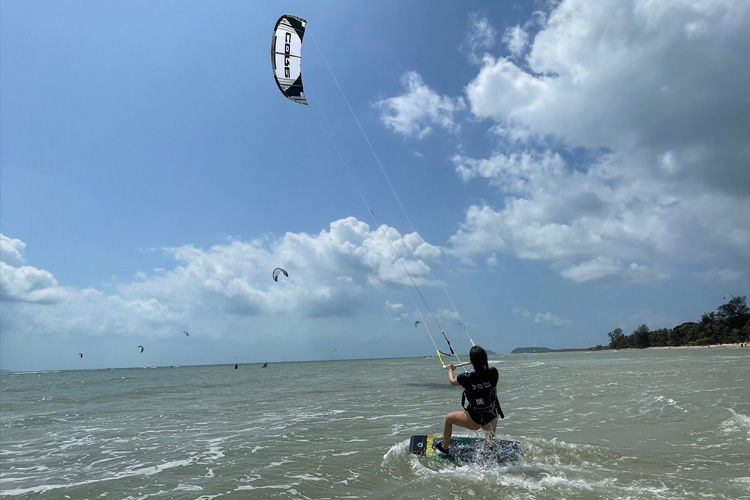

This island paradise, famed for its Full Moon Parties. Kitesurfing on Koh Phangan is perfect for beginners as well as advanced riders! The main season starts here in December where wind comes from the northeast. After a month it switches to the southeast and lasts until the middle of April, sometimes May. Both the southern and northern coasts offer sheltered bays with calm waters ideal for learning and perfecting your technique. Beginner spots are on flat and shallow lagoons in Ban Tai or Tong Sala districts in the south while experienced riders can tackle the challenging waves on the west coast in Haad Rin. Wind you can expect this time is around 10-20 knots with some bigger hits from time to time.
There is also another season that starts in the middle of June and can last until the end of September. This time the wind is stronger in general.
Island’s laid-back atmosphere, stunning scenery, and diverse activities make it a perfect balance of kitesurfing adventure and island vibes. Koh Phangan is home for Fly High Kiteboarding and we are more than happy to teach you this exciting sport.


Hua Hin is a deepwater, choppy spot located around 2 hours away from Bangkok. It’s been the most popular kitesurfing destination in Thailand for quite a long time. The wind here is stronger than on the islands as it additionally benefits from thermal winds. The season starts here in November and lasts until September. Similarly to most of Thailand, between November and March you can expect wind between 10 and 20 knots and from May to September the rainfalls with stronger shots. Hua Hin also offers a fair amount of nightlife but it’s mostly popular among older tourists looking for some fun. It’s also a Thai royal destination famous for horse riding, you’ll find a lot of vendors offering this type of service.
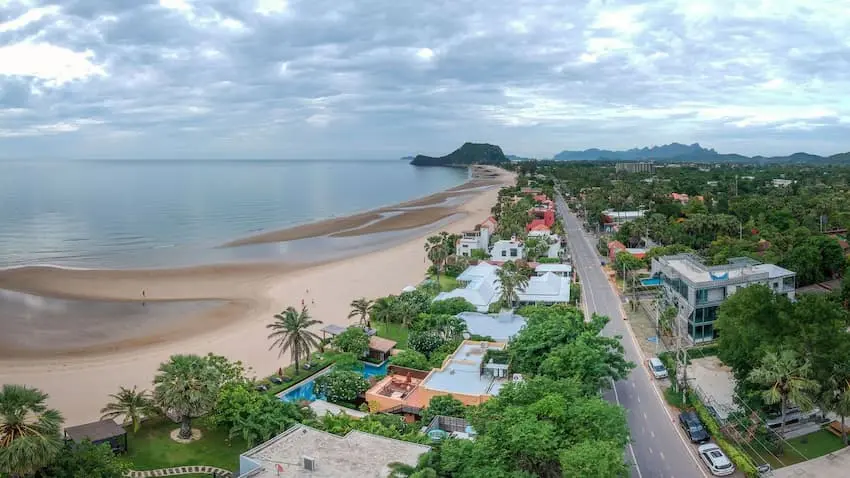

Pak Nam Pran is a fishing village gradually getting more popular among the kitesurfing community located around 30 min drive from Hua Hin. You’ll find a few luxurious resorts here and it’s more likely to be a place good for relaxation because of its tranquil atmosphere. Since the location of the spot is barely 20 km away from Hua Hin, it shares a similar wind direction and strength. The best moment to visit is from February to May where the wind is steady. There’s a fair amount of shallow water which is great for beginners. Pak Nam Pran is also known for its stunning scenery so it’s a great place to enjoy riding a bike.
If you are in the Hua Hin area, but you would like to visit the almost untouched kitespot, you can head a 20 min ride to the north of Hua Hin to the fishing / sailing village called Cha’Am. It’s not a very popular tourist destination however it’s close to Khao Nang Phanthurat Forest Park. There are no kitesurfing schools here at the moment, although you might find a kitesurfer from time to time so it’s a good idea to go there by yourself only if you can self-launch and self-land your kite. Cha’am shares season with Hua Hin, similarly to Pak Nam Pran.
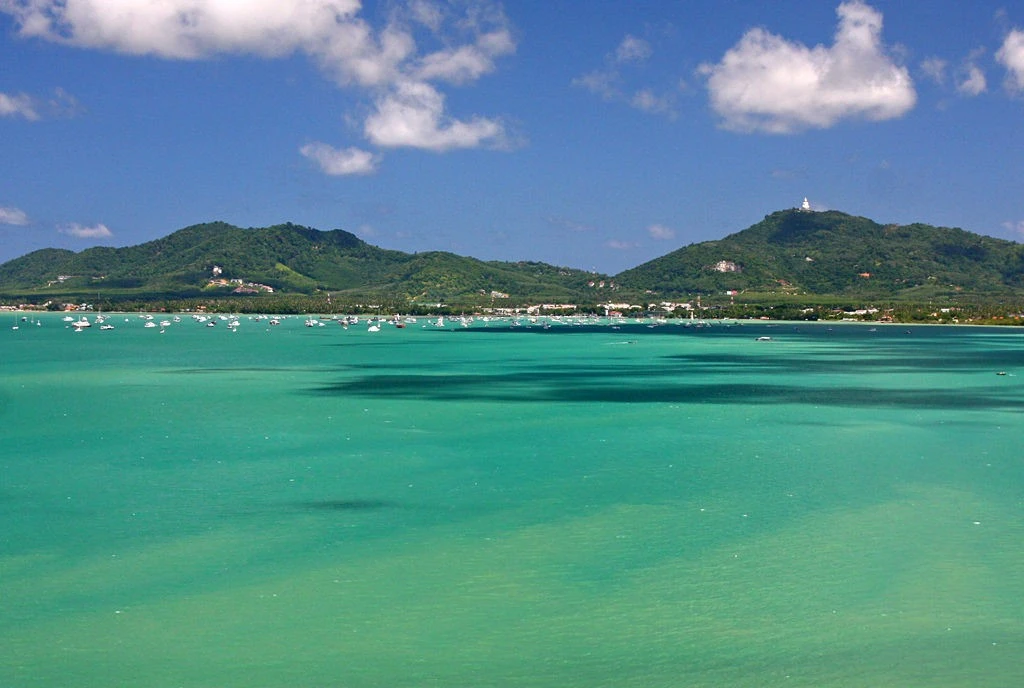

The biggest island in Thailand known for its crazy nightlife on the Bangla Road / Patong area as well as the Big Buddha monument on the top of the island. Located on the Adaman sea, the island is big enough for everybody to have something for themselves. Kitewise, there are 2 seasons here. First one with western winds starts in November and lasts until March. During this time the spot is in Chalong Bay, close to Rawaii Beach. It’s quite tricky because of its thermal wind and tide levels. Sometimes water can drop to the very low level that even having good wind will force you to walk far away to access water deep enough to do kitesurfing.
Second season starts in May and lasts until October. This time the kitesurfing spot is Nai Yang beach in the northern part of the island. During this time you can expect some stronger wind followed by rain.
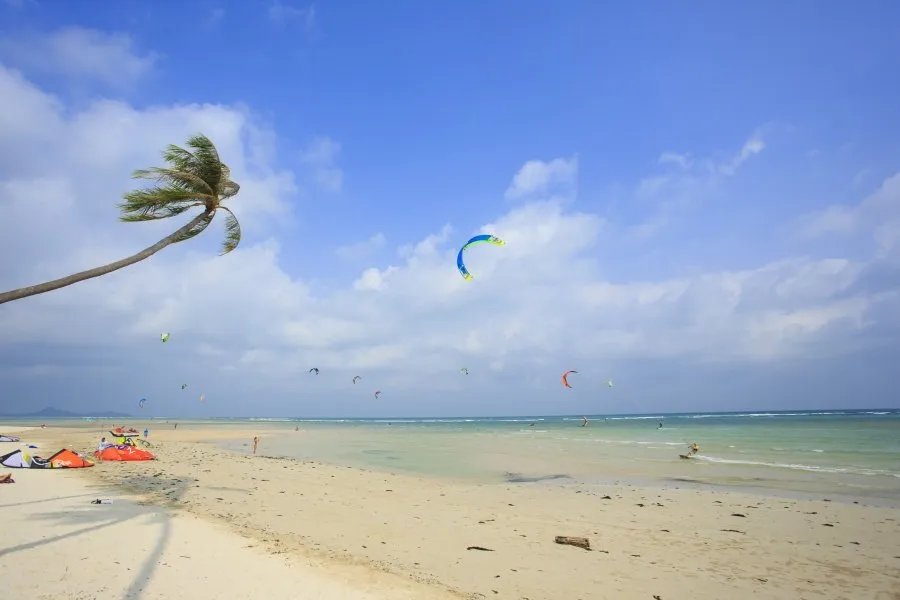

Koh Samui is the southernmost island in Gulf of Thailand. Because of it, Koh Samui shares its sibling’s kitesurfing charm, however the wind is less consistent and few knots weaker than in Phangan. Boasting several sheltered bays with consistent winds, Koh Samui is a haven for beginners and intermediates. The crystal-clear waters and stunning coral reefs add to the allure. For experienced riders, the south coast offers choppier waters and occasional waves for a more exhilarating experience. Wind season is also similar to its sister: from December to April you can kitesurf in Maenam Beach or Barn Ham beach. After your kitesurfing session, indulge in Koh Samui’s luxurious spas, delectable seafood, and city activities.
City located around 1 hour away from the famous tourist destination Pattaya. There are two seasons: first starting from November to January. Second, starting from June and finishing in September. Water there is flat and there is a fair amount of shallow area for beginners. The most popular spot is Laem Som beach however from November to January you will have to move to the west side of the bay. There are some Thai owned surf and kitesurf schools there.
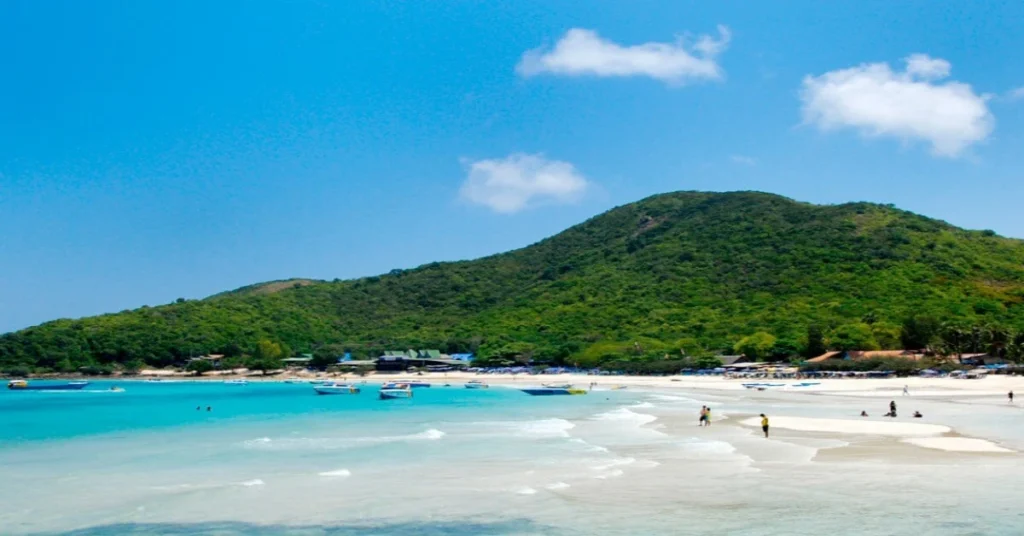

If you are looking for kitesurfing in a Miami-styled destination, Pattaya is the place to go. It’s a very famous tourist destination for its nightlife, similar to Phuket. The main spot is Jomtien beach and the season starts in November all the way to June. First part of the season is in the deep water because of the high tidel that gradually gets lower throughout the season. It’s a motor-free destination that is starting to be more popular for hydrofoiling.
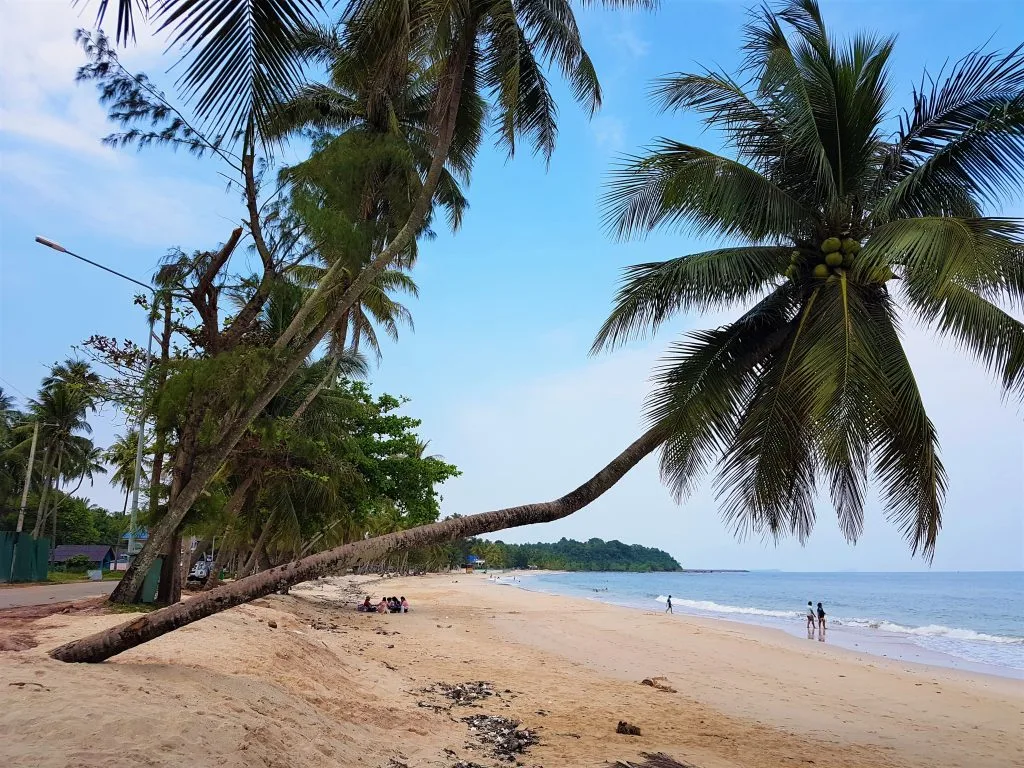

Venture further south to Chumphon, a kitesurfing frontier waiting to be explored. Offering consistent winds and a variety of spots for all skill levels, Chumphon attracts adventurous riders seeking something off the beaten path. The untouched beaches provide a breathtaking backdrop for your kitesurfing journey. It’s best to be there mid October to March and the spot is Cabana Beach. Be prepared for a more rustic experience, as there are not many other kite surfers around, the water is choppy and the wind quite strong.
Trang is the next kitesurfing secret in Thailand located around 150km from Krabi and 300km south of Phuket that is home for Hat Chao Mai National Park. Trang is the only spot in Thailand where you are able to enjoy kitesurfing almost all year on the same spot which is Pak Nem Beach. There are no kitesurf schools now there. Wind blows strong from the northeast from November to April and southwest from May to October.
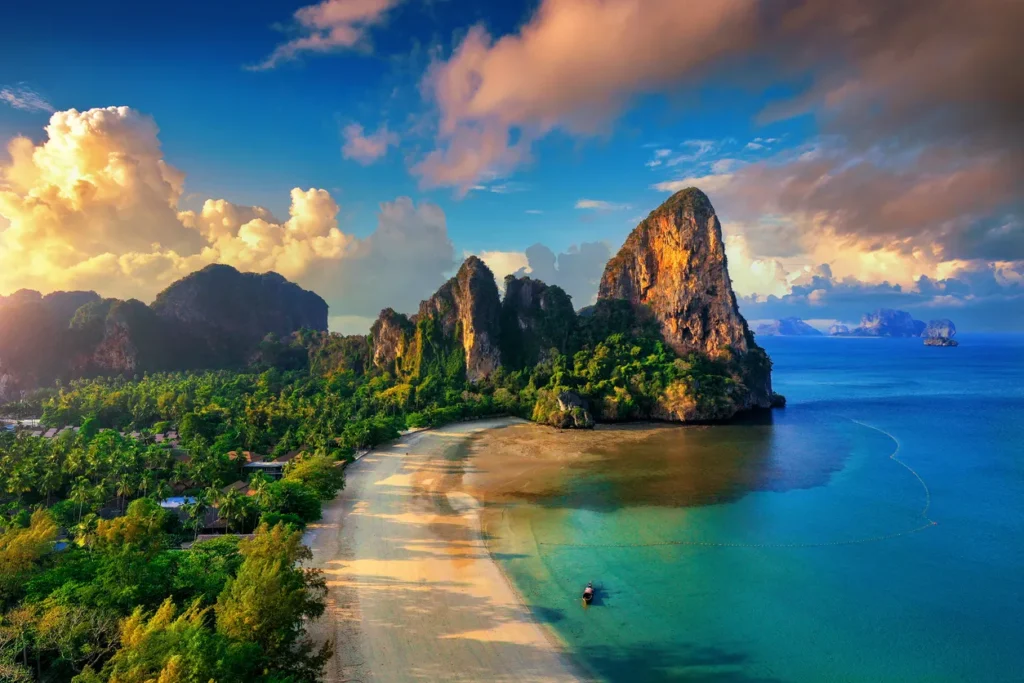

Krabi, a province in southern Thailand, is a paradise for nature lovers. Dramatic limestone cliffs jut out from the turquoise waters of the Andaman Sea, creating a stunning backdrop for idyllic beaches. It’s definitely the most picturesque destination in Thailand where you can kitesurf. The spot is Ao Nang beach however the wind is not so regular here and there is no kitesurfing school there currently. The biggest chance to catch some winds there is from May to October with it being the wettest month.


Located in Krabi province, Koh Lanta is known for its fair number of beautiful beaches, some of the best in the whole Thailand.. The best moments to come to Koh Lanta are January, May, June, July, August and December. One of the spots is Lanta Pura Resort beach. There are not any kitesurfing schools there currently. Footage to see how idyllic Koh Lanta for kitesurfing can be: Kite Surfing in Koh Lanta, Thailand • With YogaSlackers Sam Salwei
Kitesurfing is a type of sport that ‘s easy to learn and it takes significantly less time than learning any other watersports or extreme sports. Especially learning kitesurfing in Thailand because of its conditions tailored perfectly for beginners. In this section you can find out how the learning process looks like and what to expect in your kitesurfing course step by step.
Every kitesurfing course starts with a theory part that is massively important for your safety during the course as well as your safety in future.. Some kitesurfing schools underestimate this part to move as fast as possible to the water but don’t let fool yourself. Kitesurfing is an extreme sport and even though it’s easy, knowing the basics is absolutely mandatory. Most of the kitesurfing injuries come from lack of knowledge, not from crashes in the water. Usually the theory part, which are points 1-4 of this section, takes around 30-40min of the first lesson.
In this step, your instructor will talk with you about 3 factors: wind direction, wind speed and spot itself.
First factor is understanding how the wind works and where it comes from. Being able to understand what wind direction is crucial for your safety as we set up the kite equipment according to the wind direction. You’ll be taught methods how to easily find out wind direction everywhere you go. One of the methods is to rotate yourself 360 degrees and the moment you hear the sound of wind in both of your ears, your nose will show the direction the wind comes from.
Second factor is the wind speed because we choose the correct size of our sail (kite) according to it. You’ll be taught what to take in consideration choosing the size of the kite and how to choose the safe size for yourself in future. There are some websites dedicated for wind like Windguru, Windy or Windfinder where you can check wind speed daily.
Third factor is the spot where you are kitesurfing. You will need to know all potential dangers of the spot and what to be aware of when you are going to approach every new spot by yourself. Some of these “dangers” are obvious like boats but some of them might be hidden like some reef parts underwater.
Next step of theory is getting your equipment in. In general in kitesurfing all you need to have is: a kite, a board, a bar (steering tool), harness (waist or sitting) that your kite will be attached to and a safety leash.
We can distinguish types of kites by their use and their construction. When it comes to construction - the two main types of kites are: inflatable kites and foil kites.Inflatable kites are the most common around the world. If you ever see people doing kitesurfing, there is a 90% chance they were using a regular pump kite. These are the kites you need to pump up before using.The second option is a foil kite. These kites are similar to paraglide kites which means that you do not need to pump them, you just launch a kite in the air and it fills with the air getting the shape slowly. The biggest advantage of the foil kites is longer hang-time in the air which basically means that you stay a few seconds longer in the air as you jump.Another way to distinguish the kites is by their use. If you read the “Type of disciplines” section above in this article then you already know that there are few disciplines of kitesurfing: freestyle, big air, free ride, wave/strapless. Each of these disciplines will use different types of kite to maximize output of it. For example, big air kites will jump higher and wave kites will behave better when you gonna catch the wave.
Bar is your steering tool. It works almost the same way as a handlebar of the bikes or scooters. When you turn left, kite goes to the left, when you turn right, it goes to the right. Bar comes separated to the kite most of the time and has 4 lines that you need to connect to the kite.
Not much philosophy in here. Same like in snowboarding, you need the board to ride. There are few types of boards and the most popular are the twin tips which is basically a snowboarding board with no boots but straps itself. There are also other boards used in kiteboarding like directional boards for waves and strapless or foil boards for hydrofoiling or unhooked boards for freestyle.
It’s the thing you are getting your kite attached to. There are two types of harnesses. The most common is a waist harness however for some people a sitting harness would be a better option.
Leash is a very small element of your kitesurfing equipment that it’s crucial for your safety. It’s one of your safety system that you can use to disconnect yourself from the kite or secure it from losing if you use other safety system
This is the moment you are going to set up your kite for the first time. It means you will have it explained how to position it, how to secure it, how to unwind and prepare and safely connect your lines to get started! After that you’ll learn how to steer the kite in pre-launch training to understand what each movement on the bar does to your kite. Instructor will explain to you how to turn with the kite, how to make power, how to stop it and how to use each of the safety systems.
This is the last part of the theory. In this step you will have the wind window explained which basically is the 3-dimensional area your kite operates in. In kitesurfing to understand where the kite is in the air we use the upper part of clock hours so we have all hours from 9 am to 3 pm where 12 is right above your head (zenith) and 3 and 9 are the water levels left and right. The more you move the kite to the front of the wind window the more power it generates.
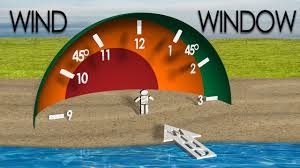

Congratulations! Your theory part of the lesson is finished. Now it’s time for real fun! The previous 4 steps took you approximately 30-45 min, now it’s time to get into the water.
Kite control is the first practical step of your course. This is the time you will learn how to steer your kite, keep it stable in the air in particular hours of the wind window as well as you will learn how to launch / land and relaunch your kite in case it drops to the water. You will also learn how to generate more power by keeping it deeper in the wind window.
Once you finish your kite control step, you will need to learn body dragging. Body drags are the maneovurs that let us rescue ourselves if the wind drops down to the point we can’t continue riding. This step is also crucial for board recovery – every time we lose it in the deep water we can body-drag back to it. If you plan to be independent rider and buy/rent the equipment, you better know how to do it smoothly. There are 4 types of body drags you will need to learn:
It’s the easiest body drag you start with. This body drag will teach you how to keep your kite stable in the air while you are moving on your chest in the water. The kite will move you either left or right and all you need is to keep it as stable as possible.
This one is very fun! Similar to the previous body drag, in this case you will generate the additional power by making the power moves. You will be asked to generate more and more power gradually to see how much power each move generates. It’s exactly the same power moves you will make to keep yourself on the board later.
This body drag is the hardest of the all body drags you are going to learn. It’s the only one in the game that will let you travel in an upwind directions so it's also the most important one. This body drag teaches you how to operate kite 1 handed while moving and using second hand as "shark fin" or "rudder" to keep upwind course.
Same like the body drag upwind with one difference. You’ll keep the board in your hand instead of having the hand underwater. We use this body drag to get back to the shore in case wind drops down to the point we are not able to ride to shore back.
Congratulations! You passed the second stage of learning which approximately took you between 1-3 lessons depending on the spot and individual abilities. Now it’s time to get on the board. In this step you will learn how to start from the water, how to make longer, regular rides and how to stop in certain areas. In this step, you still don’t know how to ride upwind, so every few rides you will get pulled downwind, eventually getting out of the board to come back to your instructor.
The last step to be considered an independent kitesurfer and to be able to rent equipment from most kitesurfing schools in the world. You will need to be able to show that you can come back to the spot you started from by the board.
In this step you will learn how to keep control of the height when you ride and how to ride upwind. This skill will let you ride comfortably in all directions.
You learnt how to ride all directions but you still can’t change them smoothly without falling to the water. Turns are not mandatory to consider yourself independent rider. But can be extremely helpful to keep your height and keep your upwind course. From this point you can keep learning safely by yourself as you don’t need the instructor anymore, however if you want to learn things significantly faster, you can always book an advanced / customized lesson with radios to practice this and all further skills.
Congratulations! You are a complete intermediate kitesurfer now. It’s time for JUMPS and some basic tricks. First jumps are always better to be learnt with the assistance of instructor as it’s way more effective and safer. You can just grab a lesson or two, get everything explained, get all your mistakes corrected and then train on your own on rented kites.
You’ll start from tiny jumps and gradually fly higher and higher. In jumping you basically have 3 phases: taking off, flying and landing phase.
Once you will learn some small jumps you can go for first rotations like backroll.
This is the most fascinating moment in kitesurfing. Choosing what you are into. You can jump already, you can do small rotations so now you need to decide what gives you the biggest rush or fun. You can choose between: freeride, freestyle, big air, strapless freestyle, wave-kitesurfing and hydrofoil. You have all disciplines explained in the first section. The hydrofoil is the only one that you would need to be introduced to and grab some lessons as the rules are a little bit different here but for the rest – you just can buy the equipment and have the best fun.
Each discipline has a different set of tricks. This is the stage you learn from YouTube videos looking for a specific trick and then trying to recreate in the water. This step basically has no end as kitesurfing is still evolving and people break each other’s records. Who knows? Maybe you are going to be next?
